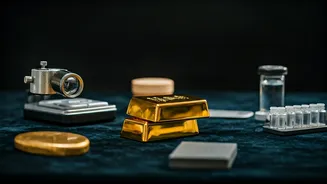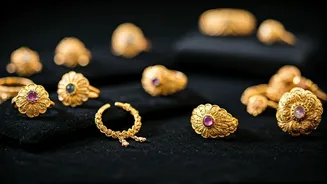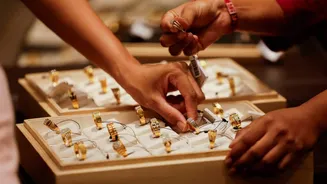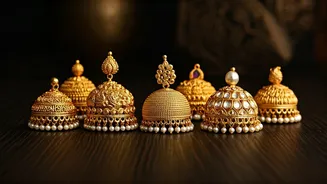Hallmark Verification First
The first step in ensuring gold's authenticity is to examine the hallmark. Look for the Bureau of Indian Standards (BIS) mark, which is a mandatory certification
in India. The BIS mark ensures that the gold item adheres to certain purity standards. Check the fineness, represented as a number like 916 for 22 karat gold. Also, review the year of hallmarking and the jeweller's identification mark. The presence of these marks indicates the gold has been tested and meets the specified purity levels. Absence of these markings should raise immediate concerns, and you should consider seeking verification elsewhere. Verify all these elements to ensure the product's quality and your peace of mind.
Visual Inspection: Detailed Look
Next, conduct a visual inspection of the gold item. Examine the surface closely, especially in areas where details are intricate. Real gold should exhibit a consistent colour throughout; any inconsistencies or spots can signal impurities or fake gold. Check for any signs of discolouration, especially green or black spots, as these may indicate the presence of other metals that are oxidizing. Look for irregularities or imperfections, as these may indicate that the gold item is not genuine or is of low quality. Use a magnifying glass to check for any imperfections such as scratches, dents, or bubbles. This thorough examination may help spot obvious signs of manipulation or low-quality craftsmanship and allow you to raise concerns to the jeweler.
Magnet Test: Non-Destructive
This is a simple, non-destructive test that can quickly provide clues about the gold's authenticity. Gold is not magnetic, so if the item sticks to a magnet, it is not pure gold. However, it's important to remember that this test alone is not conclusive. Some fake gold items are also non-magnetic, and some gold alloys may have a slight magnetic pull. If the item is attracted to the magnet, it's likely not pure gold or contains other metals. If there's no attraction, the item could still be fake. It’s always best to combine this with other verification methods to build a clearer picture of the gold’s purity and authenticity. This test should not be used as the sole method.
Nitric Acid Test: Proceed Cautiously
The nitric acid test is a more advanced method that should be performed cautiously. This test involves applying a drop of nitric acid to a small, inconspicuous area of the gold item. The reaction of the acid with the gold will indicate its purity. For example, if the item is 24K gold, the acid should not react; if it turns green, it indicates the presence of other metals. Always wear safety glasses and gloves when using nitric acid, as it is corrosive. If you're not comfortable performing this test yourself, seek professional help. The results can be tricky to interpret if you aren't familiar with the different reactions. This test provides a definitive method for determining the gold's purity.
Scratch Test: Minor Scratching Allowed
The scratch test can be applied to a non-obvious part of the gold item. Gently scratch the gold against an unglazed ceramic tile. The colour of the streak left on the tile can indicate the gold's purity. Gold will leave a gold streak. A darker streak may indicate that the gold is not pure, and other metals are present. Keep in mind that this test may cause slight damage, so use it carefully. If the streak is dark, it suggests that the gold may not be pure. This is a quick and effective test, especially when used in conjunction with other methods. Ensure to use an appropriate tile or surface for this test. Perform the scratch test discreetly, and compare the streak’s colour to known gold standards to assess its authenticity.
Professional Appraisal: The Best Way
The most reliable way to verify gold purity is to seek a professional appraisal. A qualified gemologist or jeweller has the tools and expertise to accurately assess the gold's purity. They can use a variety of techniques, including X-ray fluorescence (XRF) analysis, which is a non-destructive method that provides precise information about the gold's composition. An appraisal will offer a detailed report on the gold's purity, weight, and value, giving you confidence in your purchase. They can also identify any potential issues that may not be apparent to the untrained eye. Getting a professional appraisal is an investment, but it's an excellent way to ensure that your gold is genuine and of the expected quality, providing you with documentation and peace of mind.














